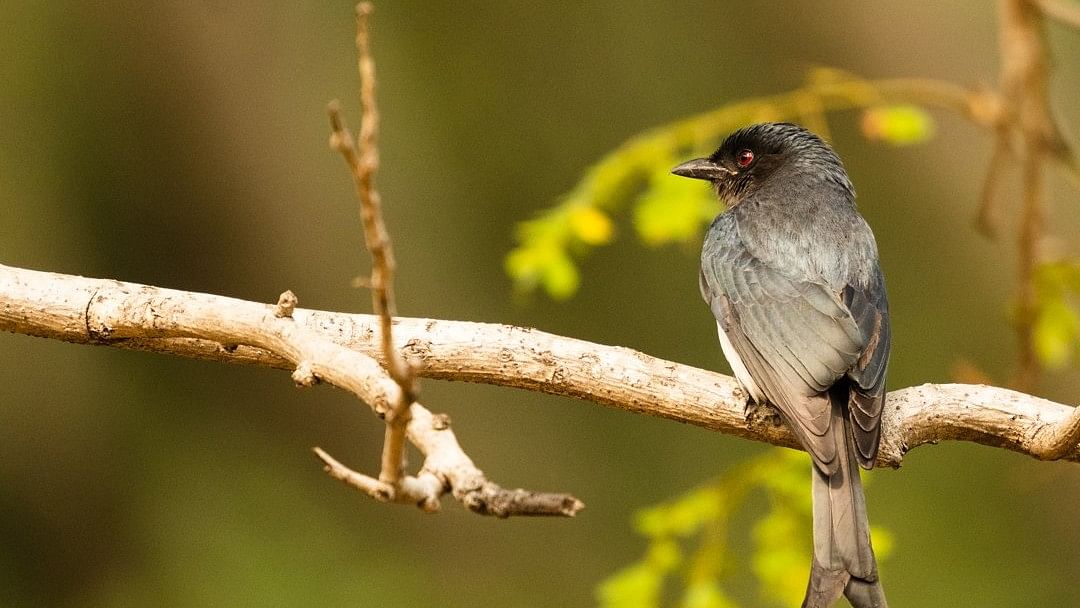
White-bellied Drongo.
Credit: Shabbir Jasdanwala
A lone crested serpent eagle heralds our entry into the stygian darkness of the jungle. She pauses to stare us down, her bare yellow talons and eyes, fashioned to evoke fear. The silence of the dense forest is palpable and serves as the perfect stage for a theatrical performance featuring these birds of prey and other predators. At precisely 6.10 am the sun seems to peep out of the sky playing hide-and-seek through the foliage and like clockwork, a loud piercing squeal shatters the silence, then a reply, then several and then it’s a symphonic retort!
God’s own amphitheatre!
“Welcome to Churna,” says our driver as we amble through one of the oldest protected forests in India — nestled deep inside the Satpura Tiger Reserve, under the Bori Range, Madhya Pradesh. Here, in the pristine wilderness, a sense of euphoria creeps in... after months of being holed up in a small city apartment, I experience the sheer joy of embracing nature in all her myriad forms, in a park that seems so untouched and unexplored, it feels like God’s own amphitheatre.
I’ve never understood the Indian mentality of a wildlife holiday being all about the tiger…the crazy pressure on guides by visitors to show them a tiger, the lack of forest etiquette and the safaris where the human species starts outnumbering the wildlife. The Satpura National Park is known to be a magnet for birds; both local and migratory because of its topography, (replete with numerous water bodies, and rivulets, gorges and waterfalls). This natural dormitory for the who’s-who of the bird community boasts of raptors like the Honey Buzzard, Black Eagle, Rufous-bellied Eagle in addition to the Malabar Pied Hornbill, Paradise Fly Catcher, Migrant Waterfowl, Bar-headed Goose, Pintail, Garganey, Pochard and Ruddy Shelduck. Rare species like the Indian Skimmer and other wading birds also drop in from time to time.
A bird-rich forest
As we plough ahead, this bird-rich forest offers some spectacular sightings — Day one was peppered with colours that represented almost every shade in my son’s paint box. The Indian Roller is one such species that captivates us as it darts through the trees the prominent blue markings on the wings, tail and belly merging gloriously against the green trees and foliage. As we moved deeper inside the jungle and sightings of sloth bear, sambar deer, leopard and other creatures on the ground caught the fancy of my co-travellers, I had my binoculars pointing upwards — my head trained to the sky!
So the crested serpent eagle and red-wattled lapwing were delights to observe both totally different in form and feature; the former fashioned to be bulky and powerful as a weight lifter and the latter dainty and sleek like a model. Day two was heralded by a cacophony of birds who felt compelled to greet us in chorus — a truly welcoming sight! The Fork-tailed Drongo and Green Bee-eater paid us habitual visits and closer to the watering holes we were treated to sightings of a painted stork and pond herons.
The slightly more deadly predators such as the black kite with wings of imposing length also flew past that morning. Due to the forest relocation programme, the herbivore and carnivore population of the forest has shot up and on a separate note, the Forest Department brought in 16 Barasingha from Kanha National Park which has increased to approximately 64 plus over time!